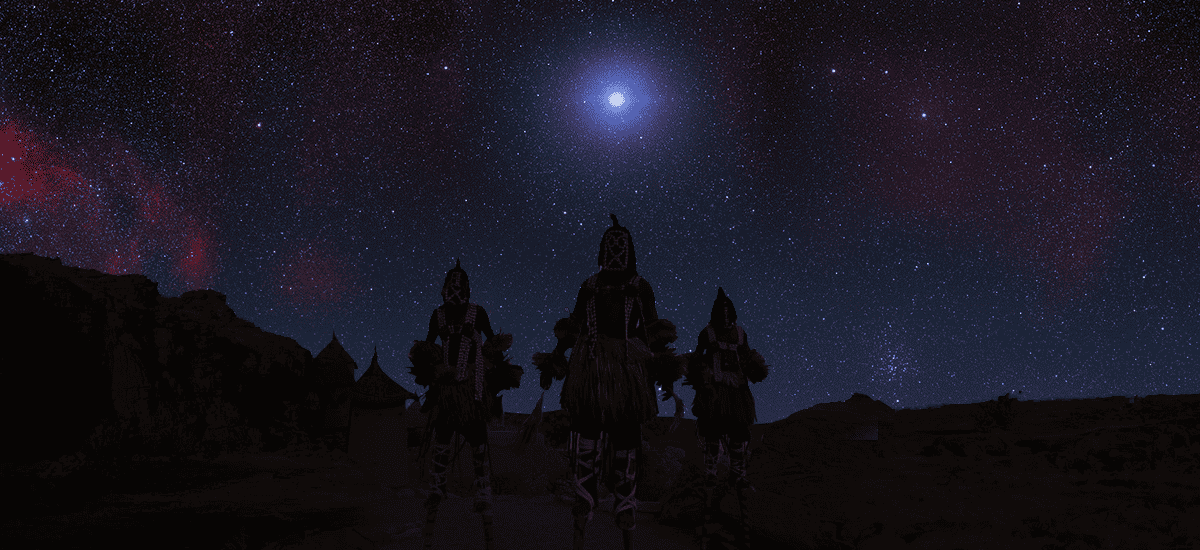Since the beginning of time Africans have measured time, seasons and cycles, and direction using the stars. Without a telescope and modern equipment’s, they are able to explore the space, they understood that in the gleam of the bright star of Sirius, there is a second star that orbits with the first, and it is a tiny star. They know the existence of the stars, but they also know the correct orbital period of the two stars. This has been recently documented by Thebe Medupi, a South African astronomer in a film title Cosmic Africa. It is his dramatized autobiography, in which he travels through Namibia and Mali, speaking with KhoiSans people and Dogon healers, diviners and hunters about their notions of the sun, the moon, the stars--making the film as much a celebration of African culture as of astronomy. At film's end Thebe is developing the world's first African ethno-astronomy class. This is his journey
Going back a bit, when I was 15, I started to question why everything was Eurocentric. Textbooks were using European things and so on. So, I used to ask myself whether it was because there was nothing Africa can offer. I refused to believe that. It remained a very big question for me for a long time, until I came across a review on African ethnoastronomy. I was very excited. I was thinking of writing a book about that, when, about a year later, I was approached by a filmmaker and a journalist about making a film.
We decided to select remote communities, where contact with the outside world was minimal, but also living communities where you could clearly and graphically show that astronomy was an important part of their lives. That’s why we selected the Khoisan people, who live on the border of Botswana and Namibia, and the Dogon people of Mali, West Africa. The Dogons still live the way they did 500 years ago. They were dignified, and very hospitable. At the beginning, it was not easy to get information from them—that’s how they protect their culture from being eroded. But once we won their trust, it was very pleasant to live among them.
In my journey, I also read about a stone observatory—stone structures in the Sahara desert in southern Egypt that were erected more than 6000 years ago; that’s more than a thousand years before the Pyramids. The stones were erected to mark the directions of north and of the summer solstice sunrise.
I spent a week with the Khoisan people, three weeks with the Dogons, and a week in the desert. It was amazing. It was fun, but it was also very harsh—temperatures were 48 °C.

One evening with the Dogons, I went with two old people to look at the stars. I asked them what was the most important constellation for them. They said the Pleiades, a star cluster, which is very important throughout the whole of Africa, actually. The stars are used for planting and agriculture. I asked this guy [for] positions of the stars, and he gave me the rising times and positions at different times of the year. I checked with my laptop, and he was very much correct. To me that proved he knew what he was talking about.
The Egyptian stones apparently contain alignments similar to those done a thousand or so years later at Stonehenge in Great Britain, but they are smaller in size. The Khoisan people made out constellations just like the ancient Greeks and other peoples. To me, it shows the commonality between Africa and the rest of the world.
The whole point about the film is that this topic was never covered before. No one knew that African people were involved in this kind of thing, so it was very special for us. And it’s a great message. You can tell kids that truly astronomy and the rest of science is a human activity, and it belongs to all of us. It makes it easy to attract young African children into science and technology.
Today we can speak of the cultural timeline of astrology in Africa.
Thebe Medupe (born 1973) is a South African astrophysicist and founding director of Astronomy Africa.
The Dogon are the people of Mali in West Africa are known for their ancient cosmology, which includes a complex system of astronomical knowledge. This knowledge was passed down orally from generation to generation, and it is only in recent years that it has been studied by Western scholars.




